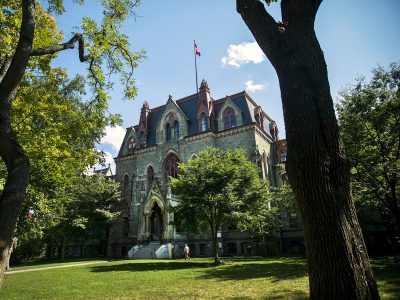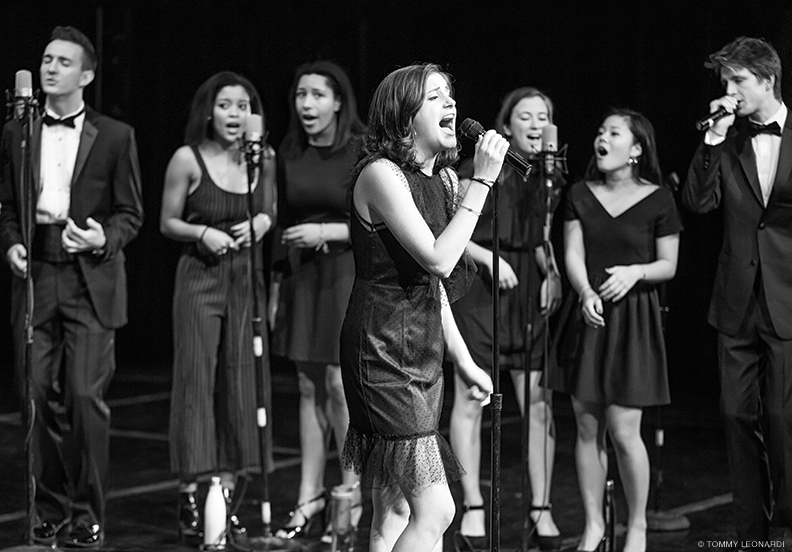
Penn’s vibrant a cappella community contains a multitude of musical styles and cultural influences. Take a listen.
BY MOLLY PETRILLA | Photography by Tommy Leonardi C’89
+ Pitch Perfect Penn
+ Meet the Groups

Sanjit Chakravarty W’19 was already tired. His freshman year at Penn had just started. He’d spent the day audition-hopping in Williams Hall, where student theater groups were casting their fall plays. He was walking toward the door, eager to head back to his room and unwind, when a sign caught his eye. Penn Masala, the University’s Hindi a cappella group, needed new singers and a business manager.
Chakravarty had never heard of the group before. He also wasn’t a singer. Sometimes he’d mess around with a Coldplay song as he practiced piano before school, much to his older sister’s annoyance. But business manager? He was a finance major. He could do that.
He turned around and found the Masala audition room. “I’m here about the business manager opening,” he told the guys inside.
It turned out Penn Masala didn’t need a business manager until the spring, but as he started to leave, one of the guys stopped him: “Hey, you’re here. You can sing something if you want.”
Chakravarty had been listening to Coldplay on his way to the theater auditions that morning. He got out his phone, pulled up the lyrics to “Yellow,” and fumbled his way through it.
“I wasn’t great at all,” he says now, “but I guess they saw some kind of potential.”
A few weeks later, he was en route to Syracuse University for his first performance with Penn Masala. He was still learning their arrangements—still learning to sing in general—but he figured this would be a pretty small show anyway. They were just a group of college kids singing songs to other college kids. Maybe 20 or 30 people would show up to watch them.
There were a few hundred people in the audience that night. Toward the end of the show, fans ran up to sing and dance near the stage. Outside, they asked for photos with seniors from the group.
Surreal , Chakravarty thought. This is surreal.
It got stranger. By that summer, he’d been in YouTube videos that hundreds of thousands of people watched. He’d also recorded songs in a professional studio. And in May 2016, he and Masala toured India, where audiences knew their Hindi/English song mash-ups by heart, showed up with fan art, and asked for autographs.
Chakravarty says his dizzying first year is one that many in Masala can relate to. And while the details vary, it’s not uncommon across Penn’s a cappella community. Every year, students who haven’t taken voice lessons or even sung in public before start the jump from newbie to polished performer. (There are many trained singers in those a cappella groups, too, of course.)
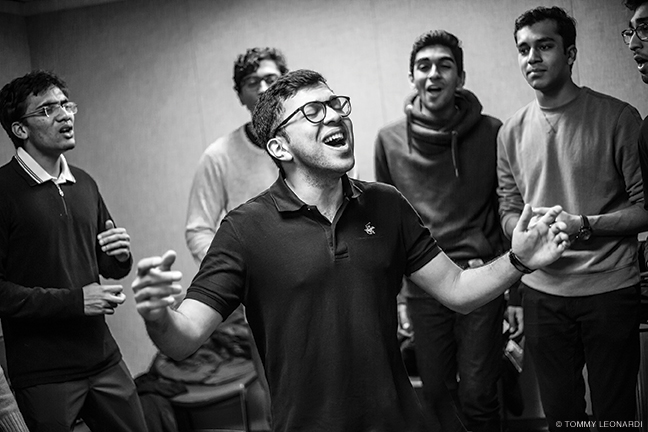
Whatever their musical interests, there are options to match. The 14 ensembles in Penn’s official A Cappella Council (mysteriously abbreviated to ACK) include groups rooted in cultural identity, musical genre, religion—and Disney music.
As a student at Penn, even if you don’t seek out their concerts, you’ll hear from at least a few a cappella groups before your four years are up. They perform at Freshmen Convocation and Spring Fling. They appear at various fraternity and sorority fundraisers. Last March, Off the Beat sang before a moderated discussion between Amy Gutmann and Joe Biden.
And a number of groups’ presence extends far beyond campus. They release professionally recorded albums on iTunes and Spotify and viral music videos on YouTube. Some have alumni on Broadway, and in Counterparts’ case, alumni who are John Legend C’99 Hon’14 [“Making a Legend,” Jan|Feb 2005].
“Penn is constantly churning out great recordings, great performances, inspiring others, and remaining at the top of the pack—that’s undeniable,” saysDeke Sharon, the guy who helped popularize college a cappella by starting the International Championship of Collegiate A Cappella and selecting tracks for an annual Best of College A Cappella album.
Today there are Penn groups that charge thousands of dollars for a single gig, groups that win regional competitions, and groups that tour the country and the world. Multiple Penn groups have performed at the White House. One has been the focus of a reality show, and another appeared in a Hollywood blockbuster. And all of them are entirely student-run.
On a brisk Wednesday in mid-November, two nights before their fall show, the Penn Counterparts came into rehearsal smiling and humming riffs. A circle of 16 chairs waited, then slowly filled with each member of the co-ed jazz/pop a cappella group.
As the vocal warm-ups began—repeated “ahh”s and “ee”s, mostly—Mateo Fortes Nu’19, Counterparts’ music director, snapped his fingers and conducted. Then the group broke into “Route 66.” Their voices soared up and out, filling the room, twisting and swirling together to make a full sound. Each part distinct but mixed into a single entity too.
That particular point came up later when Fortes asked the group “who sings next?” as they were running their concert set. He meant who’s the next featured soloist, but one guy couldn’t resist. “We all sing next,” Shiv Nadkarni C’19 said earnestly. “Let’s stop doing that. It’s everyone’s song. You know what I mean?”
“New favorite comment!” Fortes exclaimed. Before rehearsal ended that night, he’d declare at least 10 other new favorite comments.
Counterparts had the most competitive auditions of any a cappella group on campus this year. Out of 111 people who tried out, only three were selected. Two of them have perfect pitch.
In November, the group rented a sound stage in Center City to shoot a music video. At their fall show, they sold Counterparts hats and CDs of their brand-new album, Americano, recorded with The Vocal Company. (Cost to produce that album: $18,500.) Four years ago, they made it to the semifinals of the International Championship of Collegiate A Cappella.
When Counterparts formed in 1981, there was no a cappella championship. No music videos, either. There wasn’t even another co-ed a cappella group on campus yet.
The Penn Pipers came first. In 1950, they spun out of the all-male Glee Club and became Penn’s only a cappella group. By then, all the other Ivies already had their own a cappella ensembles. Most were similar glee club offshoots, starting with Yale’s famous Whiffenpoofs in 1909.
Contemporary a cappella—the style and sound most college groups employ today—didn’t emerge until the 1980s. Before that, it mostly followed barbershop or choral traditions. But as beatboxing became an art form and a cappella slipped into then-current radio hits (most notably Bobby McFerrin’s “Don’t Worry Be Happy” in 1988 and Boyz II Men’s “It’s So Hard to Say Goodbye to Yesterday” in 1991), college groups found fresh inspiration. Soon they started trying to recreate the sounds of rock instruments instead of simply singing notes.
A cappella exploded at Penn around that time too. Along with Counterparts, many other still-active groups formed on campus through the 1980s and into the early ’90s: Quaker Notes, Off the Beat, Pennsylvania Six-5000, Penny Loafers, The Inspiration, Full Measure, and The Pennchants.
Penn’s current crop of singers weren’t alive during that a cappella surge, but they were tweens and teens when the form hit another peak. Deke Sharon says the wave started on TV with both The Sing-Off and Glee in 2009. “Then Pitch Perfect came out [in 2012] and all bets were off,” he adds. “That movie just went ballistic.”
“We are now in this big boom where collegiate a cappella is not as nerdy, maybe, as it would be at a different time,” Counterparts alto Helen Nie C’18 says. That explains the 320 Penn students who auditioned for various a cappella groups this past fall, with only 64 spots in those groups up for grabs.
“It’s extremely competitive because an a cappella group can only be so big,” says Laurie McCall, the director of Platt Performing Arts House. “You can’t take 50 people. Fourteen is often your max, so lots of people get rejected.”
But for those who do make the cut, their a cappella group becomes “like a nice little family,” Nie says. Counterparts members don’t just see each other during their six-plus hours of rehearsal each week while Fortes cheerfully applauds new favorite comments. They study together, go out to eat together, cook dinner together, drive around to gigs together. The night of their rehearsal in mid-November, two members had just returned from picking up the group’s new album from a New Jersey warehouse. They’d also bought matching pink hoodies at a neighboring warehouse and were wearing them that night.
“It really is a home base for me—it’s a support system,” says Anthony Anchelowitz C’18, who is both president of Counterparts and chairman of ACK. “When I come home on a break, I’m not really talking with my parents about classes that I took. I’m talking about the incredible things I’ve gotten to do through Counterparts and through the A Cappella Council.”
Penn Masala has an off-campus house that’s been passed down through the years. Usually all five rooms are occupied by members of the group. “One thing we always say is that you come for the music but you stay for the brotherhood,” says Hariharan Ravi W’17. “Everyone in the group is extremely tight with each other.” Chakravarty says there are Masala grads who now share apartments in New York, who have launched businesses together, and whose kids grow up together.
“People say that these a cappella groups are like a fraternity, but they’re not,” says Gabriel Mann C’95, an Off the Beat alum. “Fraternities have lots of people and there’s no particular reason that you’re put together. In an a cappella group, there’s a reason—you have this purpose, this common goal.”
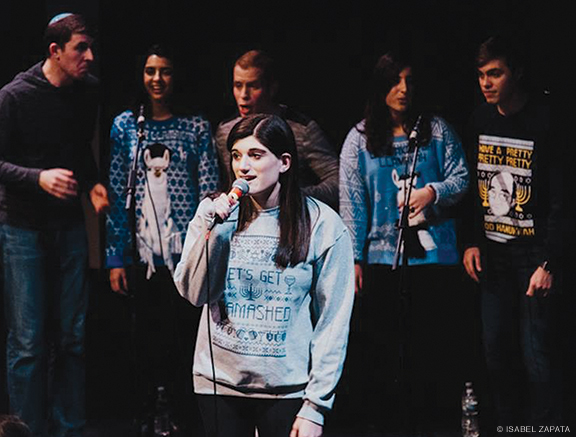
As a high schooler, Shoshana Segal C’19 wanted whichever college she chose to have a Jewish a cappella group. When she started searching, Google led her to a number of options, but one stood out: the Shabbatones at Penn.
“I really liked that their arrangements were popular and modern, and I liked that they were accessible for people who aren’t, like, very, very Jewish,” she says.
She listened to the group’s albums on Spotify before and after applying to Penn. When she found out she’d been accepted, she started following their posts on Instagram.
“It always seemed like a great group that was having fun and doing something very cool,” she says.
Now when Segal looks at that same Instagram account and sees herself there, not only a Shabbatone, but vice president of the group, “I’m like, ‘Wow, this is exactly who I wanted to be three years ago when I was applying,’” she says.
The Shabbatones are one of several a cappella groups at Penn that are based around culture or religion. There’s also Atma, an all-female South Asian fusion group; PennYo, a Chinese a cappella ensemble; Penn Sori, which sings Korean and American music; and Penn Masala. The Inspiration focuses on music from artists of African descent, and Full Measure is a Christian a cappella group.
Anchelowitz says these niches reflect Penn’s diversity and students’ eagerness to celebrate their heritage through the arts. But there’s also a little more to it: ACK only allows one group in each genre to join the council, which means new groups need a fresh hook if they want to become a University-recognized ensemble. (Being an ACK group guarantees rehearsal and performance space on campus, both of which are at a premium.)
Launched in 2001, the Shabbatones’ niche is American, Israeli, and Jewish music—and they perform it all over the country. The group had gigs booked every weekend for a solid month this past fall, and they spent their winter break touring in Miami. Segal says they mostly sing in synagogues, Jewish Community Centers, and Jewish day schools.
They’re not the only group on the move. PennYo flew to Hong Kong in January and performed with another college a cappella group there. For spring break this year, Counterparts will tour in Ireland and Off the Beat is heading down to Florida. Anchelowitz says groups try to perform as much as possible on these tours, not only to offset their travel costs but also so they don’t just become group vacations.
Most groups just want to break even when they tour. Turning a profit is tricky when you’re flying a dozen or more people around the country. Actual income usually washes in during the rest of the year, mostly from one-off gigs and ticket sales to shows on campus. According to Jacob Pardo C’18, a past Shabbatones president, the group charges $2,000 for an hour of music when they perform off campus, though they do negotiate. Anchelowitz says Counterparts’ fees range from free up to $2,000, depending on a host of factors.
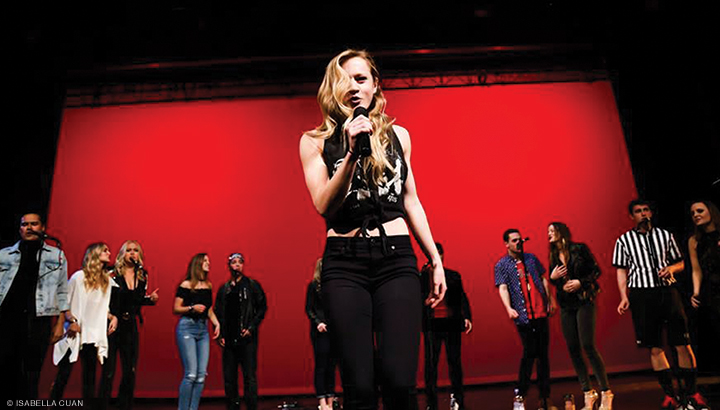
Brian Park C’19, president of Off the Beat, says his group typically charges $500 for a 15-minute set. With recent albums costing Off the Beat $17,000 to record, “gigs become a high priority,” Park says. “I know I’ve skipped a lot of classes to go to gigs, perform, and make money for an album.”
Gigs also build up a group’s cachet, helping propel them toward bigger and better opportunities. In 2014, the Shabbatones performed at the White House Hanukkah party, including a private set for the Obamas. In 2015, Off the Beat sang backup for a band whose song they’d covered when the group came to Philly. This past December, Quaker Notes opened for perhaps the biggest a cappella group in the world—Pentatonix—at a 3,500-seat local show.
Those high-profile gigs—along with tours, albums, repertoire, rehearsal schedules, music video logistics, and everything else, really—are managed by the students in each a cappella group.
“These groups are some of the best training ground for what life is going to be like,” says Sharon, who sang with the Beelzebubs at Tufts University. “As much as I enjoyed my classes, being in an a cappella group is where I really figured out conflict resolution and leading your peers and learning how to follow as well as lead. It’s where I learned how to listen and have difficult discussions and create something that’s really wonderful without any rules or guidelines or faculty interference.”
“Everything that these college a cappella groups create is 100 percent them,” Sharon continues. “It’s not just their voices. It’s their work, their infrastructure, their resources—everything. It prepares you for entrepreneurship, it prepares you to work on small teams or to join a big company—to bring a fresh perspective.”
It prepares students for actual careers in music, too, though at Penn those alumni are more the exception than the rule. Perhaps the most famous of them, John Legend, went to the ICCA finals with Counterparts in 1997. (Sharon remembers Legend, known then as John Stephens, as “a young, very eager music director with an exacting, very precise and driven nature about him.”)
Gabriel Mann is now a composer who writes music for TV’s long-running Modern Family, including its catchy theme. He credits Off the Beat with transforming him from premed to musician. When he joined the group in 1991, they had only existed for three years. Mann began arranging songs right away and became music director his junior and senior years.
“We were doing music that was hot off the press—literally had been on the radio that week—and we would take that song and do our own version of it,” he says. “At that point, that was kind of a new thing” for a cappella.
His arrangement of the Red Hot Chili Peppers’ “Soul to Squeeze,” which he also sang lead on, was included on the first Best of College A Cappella album that Sharon ever assembled. (Counterparts had a track on there too.)
“It changed my view of music in general,” Mann says of Off the Beat. “I had this working ensemble that I could experiment with—it was an amazing laboratory for me.”
Sharon calls Off the Beat “one of the most pioneering groups of the ’90s.” He says they were also one of the first mixed-gender groups to gain international attention. “They were fresh, and they developed this new sound and texture,” Sharon adds. “Of course, Gabe was a big part of making that group what they are.”
Composer Siddhartha Khosla C’98, who creates music for the television series This Is Us [“This is Us is His,” Sep|Oct 2017], now in its second season, also got his start in Off the Beat. He was Penn Masala’s first music director too. At that time—1996—there were no other Hindi a cappella groups. Not just in Penn’s a cappella community, but anywhere.
“There was so much excitement about what they were doing,” Khosla remembers. “They knew it was something special, something different.”
“They were really one of the first groups to say, we have a clear cultural identity and a musical identity other than just, ‘We sing songs,’” Sharon says.
From the beginning, the group mashed together English pop songs and Hindi hits. Chakravartysays the group’s music has “gotten people through a lot of tough times.” He understands the split identities that many Indian-Americans experience. Growing up in Dubai, Chakravarty spoke with a different accent at school than the one he used at home and his parents came from a different background than many of his friends’ parents.
“Here’s a group that’s like, ‘Hey, you can be both people,’” he says of Masala and their fused songs.
That broad inclusiveness helps explain the sell-out crowds who come see Masala on tour, the 50-plus universities they’ve performed at, and the fan who showed up to a show in India with the Masala logo tattooed on her hand.
Prashant Ramesh EAS’16 GEng’18, who was the group’s music director for two years, says the mash-up process starts with keeping close tabs on popular songs in both South Asian and Western music. “I kept a long list of songs that I found interesting, and I was constantly listening to them and looking for any overlap in the chords or melody or tempo with my long list of Western songs,” he says.
The group is also known for their viral YouTube videos. A handful have topped a million views. One is sitting at 6.6 million. While most Penn groups have a few hundred people who’ve “liked” their Facebook page—maybe a few thousand for some of the more well-known groups—Masala has over 136,000 Facebook likes. It’s not unusual for their posts to quickly hit 200,000 views. In December, a casual cell phone video titled “Singing in the Winter Snow!” posted on Facebook had 50,000 views within a few days.
Sharon says that Masala represents where college a cappella is today: instead of wearing bow ties in tiny auditoriums, groups make viral videos and tour the world. “And yet they’re doing it on their own terms,” he says of Masala. “They’re not chasing popular music. They’re making great music that reflects who they are and the culture that they come from, and people are saying, ‘Wow, this is amazing.’ And their star continues to rise.”
Even students from other Penn a cappella groups point to Masala as the best-known and highest-profile. “They sell out Irvine [Auditorium],” said Counterparts’ Nie. “I don’t think there’s a world in which we’d be able to sell out a thousand tickets.”
Off the Beat felt the frenzy around collegiate a cappella when they stepped in front of a camera crew in 2016. The co-ed rock/pop ensemble appeared in a documentary series called Sing It On, which followed several groups through the International Championship of Collegiate A Cappella.
Executive produced by Legend, the show aired on a lesser-known cable network (Pop TV) and didn’t have a huge viewership. Still, Off the Beat members have been recognized off-screen and there are now GIFs of their faces floating around the internet.
Sing It On wasn’t the first TV show about a cappella. Sharon helped produce and music direct The Sing-Off—an a cappella reality competition show that lasted five seasons on NBC, from 2009 to 2014. Then there are the Pitch Perfect movies; the Pentatonix YouTube channel with 14 million subscribers; the sold-out shows by Straight No Chaser, a professional a cappella group that started at Indiana University in the mid-1990s.
Why do people care about a cappella? Why are they willing to watch movies and TV shows about it? To search for it on YouTube? To buy albums filled with it, or at least load them onto their Spotify lists? It’s such a simple concept: a bunch of voices blending together without instruments. And Sharon says that’s exactly why it appeals.
“People long for that sense of humanity that has largely been stripped from current popular music because everything is auto-tuned and synthesized and mechanized and polished and perfected,” he says. “I think a lot of people are turning to a cappella because it breathes life into music.”
“Throughout human history, everybody sang,” he adds. “A hundred years ago, if you wanted Christmas carols, you made Christmas carols. Now people are afraid to sing, but they also long to sing because like crickets and birds and whales, we’re biologically programmed to sing.”
It’s not the only instrument-free music out there. But Mann says an a cappella group is closer to a miniature orchestra than a choir. As he sees it, choirs have so many voices that “it’s like one big mass of vocal that just goes from low to high.” With a cappella, you can hear each individual voice while at the same time soaking in the blended sound. As Nadkarni said, it’s everyone’s song.
“A lot of people talk about how there’s some kind of magical, elemental thing about the human voice,” Mann says. “It’s not a digital instrument. It comes out of your throat. And everybody’s voice sounds a little different.” And if the voice is what we latch onto in popular music, the thing we notice most, then what’s better than an ensemble of all voices—instead of one lead singer, an entire group of them?
But there’s also an added pressure in arranging songs for a cappella. Since a cappella groups sing other people’s music, their arrangement “has to be better and more interesting, has to go farther, and has to give the lead vocalist more of an opportunity to shine than the original,” Mann says. “Otherwise you’re a cover band.”
After Chakravarty lurched through his impromptu Masala audition, to his surprise, he was called back for a second round. He had 48 hours to learn a Hindi song and a John Mayer tune that the group had assigned him—and this time, he practiced.
Back inside the audition room, he sang his two songs. Then the group taught him their popular mash-up—a mix of “Don’t Stop Believin’” and “Dosti”—and invited him to stand in the center of their performance arc and sing it with them.
“The music director counted in and everyone just burst into song,” he remembers. “I’m in the middle and everyone’s singing at me. It’s this huge sound wave that’s hitting you, but all the different voice parts are locked together.”
Then the lead vocal and percussion joined in. “That’s when it all clicked,” he says. “All of a sudden, there was a song. When you’re singing a tu-doo or a boo-bop, it doesn’t mean anything. But all of it mixed together—it’s like we’re one voice now.”
That voice is in constant flux, though. Not only in Masala but in every campus a cappella group.By this time next year, they all will have lost some members to graduation and gained new ones through open auditions. They’ll still be following their missions—to sing rock or pop or Hindi or Hebrew music—but they’ll also sound different than they did this year, or the year before, or next year. As Mann says, you hear every single voice in an a cappella group. That means swapping out even one singer can affect a group’s overall sound.
When Chakravarty joined the arc that day, it changed the group—a small shift but still a shift. Masala embraces those changes. Instead of fighting to sound the same year to year, they base their repertoire on their membership, not the other way around.
A class of seniors with talented R&B singers and guys who have classical training may graduate, but then a few freshmen who can nail rock songs might join that fall. “What we perform and what we arrange changes to reflect that shift,” Ravi says. “That’s why our sound stays fresh. Every album is different to reflect the different talent that the group brings in.”
That’s why, in any a cappella group at Penn, even the same arrangement performed a year apart can sound at least a little different.
But Mann says there’s one constant: “When someone cares, you can just tell. The group gets better.”
Because Penn’s a cappella groups are so serious and focused, because there are so many someones who care, because their output is so polished and visible, it’s easy to forget that they’re all still students who do this for fun. But the students remember.
“PennYo is actually a pun on the Chinese word for friend, and I think at the very heart, that’s still what we are,” says Kenneth Ye W’18, who sings bass in the group. “Whether we’re touring, whether we’re putting out albums, I don’t think that’s necessarily what’s most important to us in the group. We’re all college students—a great group of friends doing something we care about.”
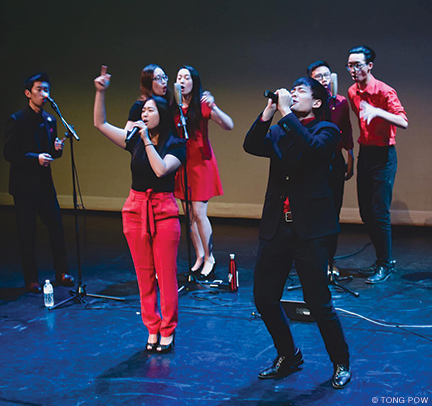
Pitch Perfect Penn
When Pitch Perfect 3 came out three days before Christmas 2017 , it was a strong reminder of Penn’s links to the juggernaut franchise.
Elizabeth Banks C’96 [“How to Succeed in Show Business by Really, Really Trying,” Jan|Feb 2010] and her husband Max Handelman C’95 produced all three Pitch Perfect movies, and they’ve acknowledged that Penn’s robust a cappella scene provided inspiration.
“She told me, ‘I never sang a cappella, but it was such a huge part of campus life, I got so much of it experientially, just being around it,’” says Deke Sharon, the music director on all three Pitch Perfect installments.
Banks appears in each movie, and she directed the second one. While working on the sequel, she began looking for a South Asian a cappella group to feature. Sharon immediately suggested Penn Masala.
The group flew to Baton Rouge, Louisiana, in 2014 to film their cameo moment in a montage of a cappella groups singing “Any Way You Want It” in different languages.
She really wanted that scene to be anchored by Penn Masala,” Sharon remembers, “and they play a big role in it.”
After the sequel made almost three times what the original did, a third installment was inevitable. This time, another Penn grad was tapped to direct: Trish Sie C’94.
Before Pitch Perfect 3, Sie’s directing resume included a 2014 movie in the Step Up franchise and a list of viral videos for the band OK Go. In December, she told the Washington Post that directing a Pitch Perfect moviewas “terrifying.”
“The stakes are very high,” she said. “The Pitch Perfect world is so known and established and I am a big fan of the franchise and I’m a big fan of Elizabeth Banks, so knew I had big shoes to fill. I knew it was like, jump in the deep end … and you’re either going to do this well or you’re going to fail horribly and it will be the end of your career.”
The movie grossed $67.5 million in its first 12 days, pushing the franchise past the $500 million mark worldwide. Sie has already been quoted saying that “there’s always going to be room for Pitch Perfect movies as long as people see them.” Sounds like there could be more Penn Perfect on the horizon. —MP
Meet the Groups
Penn’s A Cappella Council (ACK) consists of 14 groups.
Atma
Year founded: 2002
Niche: All-female South Asian fusion
Album count: 2
Quick fact: This year they donated money from their fall show ticket sales to Hurricane Maria relief efforts.
Counterparts
Year founded: 1981
Niche: Co-ed jazz and pop
Album count: 15+
Quick fact: As a student, John Legend C’99 Hon’14 led the group to ICCA finals in New York.
Disney A Cappella
Year founded: 2011
Niche: “All-Disney-all-the-time”
Quick fact: They donate roughly $500 from their spring show every year to charity and perform in local hospitals.
Full Measure
Year founded: 1991
Niche: Christian songs
Album count: 7
Quick fact: In 2015, they raised over $6,000 on Kickstarter to fund their most recent album, Reason to Sing.
Off the Beat
Year founded: 1987
Niche: Co-ed modern rock and pop
Album count: 25
Quick fact: They’ve won over 30 Contemporary A Cappella Recording Awards and have been included on 16 volumes of the annual Best of College A Cappella album.
Pennchants
Year founded: 1989
Niche: All-male
Quick fact: In 1991, they won Penn’s first—and to date, only—intra-Penn a cappella competition; in 2016, they reached the ICCA quarterfinal round.
Penn Masala
Year founded: 1996
Niche: All-male South Asian fusion
Album count: 10
Quick fact: They’ve performed at the White House for President Obama, at the Indian International Film Academy Awards, and throughout India and the US.
PennYo
Year founded: 2002
Niche: Chinese pop (mostly)
Album count: 4
Quick fact: As the US’s first collegiate Chinese a cappella group, PennYo has toured Shanghai, Taiwan, Hong Kong, and Singapore.
Pennsylvania Six-5000
Year founded: 1980
Niche: All-male comedy
Quick fact: The group accepted its first female member this year.
Penny Loafers
Year founded: 1986
Niche: Co-ed pop/indie
Quick fact: They welcomed eight new members this year—the most of any ACK group.
Penn Sori
Year founded: 2005
Niche: Korean-American pop
Quick fact: Aside from singing, their concerts also feature comedic skits and videos.
Quaker Notes
Year founded: 1980
Niche: All-female
Quick fact: The first a cappella group at Penn founded as such.
Shabbatones
Year founded: 2001
Niche: American, Israeli, and Jewish music
Album count: 7
Quick fact: The group doesn’t use sheet music; when a member arranges a song, they sing each voice part, record it, and distribute that recording for others to practice with.
The Inspiration
Year founded: 1989
Niche: Music written and/or performed by artists of African descent
Album count: 3
Quick fact: In the last several years, their repertoire has included songs originally made famous by Bob Marley, the Jackson 5, Gladys Knight, and Ladysmith Black Mombazo.
The ACK-less Pack
Several a cappella groups on campus operate outside the ACK. They include:
Penn Pipers
Year founded: 1950
Niche: Everything from doo-wop and barbershop to current pop
Quick fact: Still technically a subset of the Glee Club, the Pipers perform along with the Club; as a result, they fall under the Singers, Musicians, and Comedians Council.
Dischord
Year founded: 1998
Niche: Pop, rock, indie, and alternative
Album count: 2
Quick fact: A quirky off-campus gig this past December: Music Bingo at City Tap House.
Keynotes
Year founded: 2010
Niche: Classic rock, indie pop, R&B, and more
Album count: 2 EPs
Quick fact: This group is all about variety—everything from The Strokes to Ra Ra Riot to John Legend is fair game.
Molly Petrilla C’06 writes frequently for the Gazette and is the magazine’s arts and culture blogger.




